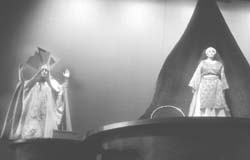|
News
|
|
|
Perspectives
|
|
|
Arts
|
|
|
Sports
|
|
|
Other
|
|

Native American Tales Retold In Mystical Opera
Coyote Tales a Visually Stunning Production
by Kate Waimey and Liz Heron

|
|
If You Want To Sing Out: Oral tradition reached Operatic heights Wednesday
(photo by Liz Fox) |
One doesn't normally envision a Native American maiden breaking into an operatic soprano, but the Conservatory Opera Theatre's production of Coyote Tales, composed by Henry Mollicone with libretto by Sheldon Harnick, manages to pull off the unlikely marriage of opera and the oral tradition of American Indian tribes with panache.
The opera, which consists of five tales taken from the Crow, Okanagon, Karok, Klamoth and Hopi tribes, recounts events in the life of Coyote, a trickster seen throughout many cultures.
Oberlin's production marks the second time Coyote Tales has been brought to the stage since its premiere two years ago in Kansas City, and although the Con's performance was exuberant, it remains to be seen whether the opera will become part of the future repertoire.
The nontraditional production was supported by a fantastical set and technical direction. Circular platforms, designed by Michael Louis Grube, conveyed the significance of the cyclical nature of life and the universe, and Jen Groseth's masterful use of sidelighting through a scrim lent a mystical quality to the performance.
The cast was universally excellent, with especially notable vocals by senior Peter Miraldo Tantsits as Coyote, sophomore Malia Bendi Merad as the Star, senior Rebecca Ringle as Fox and sophomore David Youngs as the Storyteller. The youthful performance, populated by a colorful cast of animal characters dressed in eye-catching garb created by Chris Flaharty, at times almost resembled a Disney movie and is sure to enthrall children in the audience.
The first act told four of the five Coyote legends, in which the vain trickster uses his cunning and cleverness to create playmates, outwit opponents and survive to see his next adventure.
Coyote lives alone in a world made only of water and rocks, and longs for other creatures to share his life with. The Sun helps him to create two ducks (senior Rachel Sliker and junior Scott Skiba) and with their help - although he takes all the credit for himself - Coyote is soon sharing his world with a multitude of animals, humans, flora and fauna. Coyote goes on to steal fire from horrendous creatures called Skookums, played by juniors Marcy Stonikas and Charlene Wass and sophomore Vera Savage, exact a promise from the Sun that he will always come back to life and fall in love with an unreachable star.
The sequence of Coyote's romance with the star is the most stunning of the whole production, using innovative lighting to create an icy and otherworldly atmosphere. Merad's glittery white robes lend visual beauty to the sweetness of her vocals, and it is easy to see why the Coyote finds her so irresistible.
One of weaker elements of the first act was its slow pace. During interludes when movement could have enlivened the performance, poor use of the stage and lack of effective choreography sucked the tension and urgency out of much of the action, creating spaces that were musically enjoyable but visually dead.
The second act concerned Coyote's ability to forget his first love and move on to another. Although Coyote loves the sought-after Maiden of Oraibi, played by senior Hannah Waldman, he resorts to deception to steal her from her chosen suitor, senior Jonathan Stinson's Pavayoykyasi. The typical operatic plot twist of competition over a virtuous woman that ends in her humiliation added an unwelcome element to the production. While this act allowed more character development for the characters, their views were eventually shown to be antiquated, an unexpected turn in such a progressive production.
The opera's introduction and finale used scenes in front of the scrim between males across multiple generations of a family which emphasized the theme of the never-ending circle of life in Native American tales, although the use of white, male storytellers was questionable considering the culture the opera incorporated.
Mollicone, acting as guest conductor of the Oberlin Orchestra, created music that was enchanting though traditional. The only concession Millicone made to the Native American roots of the legends was a soaring, persistent flute solo and dignified percussion that brought to mind the stoic nature of Native American culture, but several sections, especially the sequence in the stars, more than made up for the lack of authenticity with beauty and emotion.
Coyote Tales, appearing in Hall Auditorium Nov. 17-19, manages to take its unusual material to enjoyable and visually stunning heights. The capable performances of the Conservatory cast transcend a story that, while culturally rich, may be unsuited to what is traditionally seen on opera's stage.
Copyright © 2000, The Oberlin Review.
Volume 129, Number 9, November 17, 2000
Contact us with your comments and suggestions.